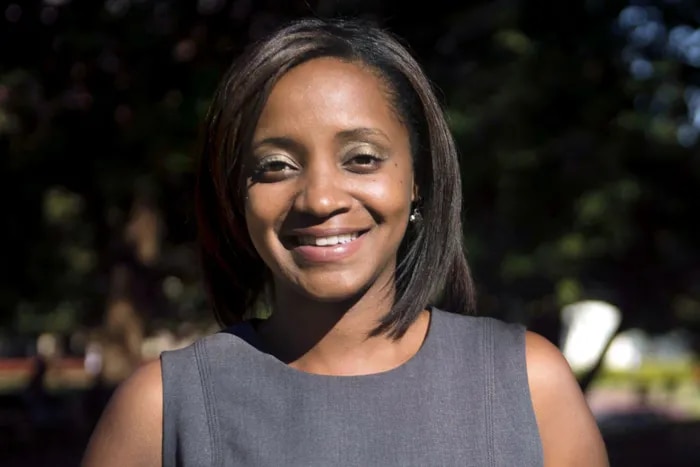— My journey towards becoming a death doula

Dana Purdom taps into her deep intuition to find her calling as a death doula.
By Dana Purdom
When I was as young as four years old, my mother would send me to my grandparents’ home to stay during the summer months. I was this little girl, neatly coiffed, dressed impeccably, and placed on a plane to fly across many states to Leakesville, Mississippi. I was a quiet and reserved child, and shy, which, I believe, others perceived as timidity and an inability to fit in. But I knew this was not true.
I was deeply intuitive, sensing, empathetic, and feeling all things around me. I wasn’t quiet. I was observant. I wasn’t shy. I was curiously aware. I wasn’t timid or unable to blend in. I was simply different. And this made others uncomfortable in ways I couldn’t name or remedy at such a tender age. So I shrank into myself and sat quietly as I watched others – aunts and uncles, cousins, friends – live their lives out loud. The only people I felt understood and knew me were my grandparents. They had a way of communicating, seeing and loving me in ways I can only attribute to them also being intuitive.
During those summers. I spent hours wandering in the fields and deep woods, exploring and communing with nature. I heard the sounds of animals moving from one place to another, giving instructions of where they were headed next. I would listen to the trees, the leaves and the brush as they sang, sending messages to one another of what season it was, and whether or not to bend and stretch when the breath of God blew on them.
And though these times were glorious, expansive, and faith-forming for me – instilling a sense of other-worldly trust and peace – there were moments of fear of the unknown, of otherworldly happenings that I couldn’t explain.
At times, asleep in the back room of my grandparent’s home, I would be overcome by a weighted feeling, making it difficult to breathe. Subconsciously, I was taken to a deep, dark, unknown place. No matter how hard I fought – to get away, to breathe, to scream – it was pointless, as the grip on me was too great to overcome.
“The witch was riding you,” a family member told me.
Whenever this happened, it would physically feel as if I was experiencing death, or the dying process. First: asphyxiation, immobility and panic would set it in because somehow, even in this state of paralysis, I knew death was imminent. And then, an unwavering calm, a gentle peace, a release or surrender to the unknown would take over, shortly after the “witch riding my back” dismounted and the paralysis ended.
These moments are what I understand to be my induction into the mystical world of death and dying. As these moments continued to happen over the years while visiting my grandparents, I began to intimately connect with the peaceful surrender of death. It no longer frightened me, but instead, drew me closer. I wanted to know more about what I was experiencing and the visions I saw. I wanted to know more about death and its transcendental relation to the beyond.
Early on, I couldn’t comprehend my curiosity about death or why these experiences happened to me. But I’ve come to understand this mystical phenomenon as a gift, a blessing and a means to serve others by becoming a death doula.
A culturally spiritual call
We live in a death-denying culture. But because of my childhood, the draw of the witch that was riding my back, and my growing intimacy with death, my curiosity grew into a deep passion: what happens, I wondered, when a physical body is no longer present in the natural world and has returned to its original form as a spirit, transitioning into its next phase of life?
For me, death is never ending; it is a transition from one life-form to the next. I am a soul cultivator, one who seeks to hear the heart of others, beyond the words they speak, desiring to reflect back to them the love, care, and peace they long for in their lives. If they never received this type of care in life, if I can give that to them in death, I will have lived fully into my call of “doing the work my soul must have,” as theologian Katie Geneva Cannon challenges each of us to do.
For me, death is never ending; it is a transition from one life-form to the next.
Like a midwife who assists in the process of birthing, a death doula “guides a person who is transitioning to death and their loved ones through the dying process,” according to the International End-of-Life Doula Association. Death doulas have existed as long as death itself; culturally, however, Black death doulas have specifically answered the spiritual call between Black people and their tormented, historical relationship to death and dying. This became more pronounced during the COVID-19 pandemic and the growth of social movements focusing on Black and brown lives — and deaths.
“The inequities in the way we live and die could not have become more apparent during this time, coupling both the pandemic and social movements we’ve witnessed in the last two years,” according to grief consultant Alica Forneret in a story on refinery29.com. Forneret also is the founder of PAUSE, which creates culturally specific spaces that provide end-of-life resources and grief support.
Nikki Giovanni once said, “death is a slave’s freedom.” Black people’s history with colonized culture has demanded that the care and personal needs of its own community regarding death and dying be met in ways that greater society doesn’t recognize.
“God’s salvation is a liberating event,” James Cone wrote in his book, The Cross and the Lynching Tree, “in the lives of all who are struggling for survival and dignity in a world bent on denying their humanity.”
New rhetorics of lynching and continual perpetuation of Black tropes dehumanize and distort one’s humanity in death. These are primary reasons why Black culture, by restoring power and dignity to the dead, has taken personal agency in God’s vision for humanity. Black funerals, therefore, are celebrations that honor the life that was lived on this side of eternity, and they rejoice in the transition into the next.
And this was what our ancestors did in remote, secret places: they practiced sacred religious traditions because they were prohibited from performing funerals or any traditions that commemorated the dead. Black funerals were once one of the only spaces not permeated with Whiteness, where we could live into our traditions in our own sacred ways.
And so, more and more Black people, by becoming or by employing death doulas, are seeking to protect the knowledge that not only Black lives matter, but also Black deaths.
Black ancestry has taught us to acknowledge death as a moment of joy, to celebrate the transition from pain and suffering in this world, to that of being in the arms of their Creator, where they will walk around heaven all day, as the song goes. Funerals, for instance, are called “homegoing services,” and are outpourings of both joy and grief. Helping the dying do so in dignity while remembering and honoring ancestral traditions, and ensuring that the family of the dying person is nurtured, became the impetus that moved me in the direction of becoming a death doula.
Black ancestry has taught us to acknowledge death as a moment of joy, to celebrate the transition from pain and suffering in this world, to that of being in the arms of their Creator.
While there are currently no licensure requirements to become a death doula, organizations exist to provide death doula certification and training. Going With Grace (goingwithgrace.com) offers death doula/end-of-life training “steeped in ancient wisdom traditions adapted to modern times” and prepares individuals to take the National End-of-Life Doula (NEDA) proficiency assessment. Passing this curriculum exam, according to the NEDA website, earns the doulas a badge that assures them and the families they assist that the doula has competencies and knowledge around, among other things, spirituality, the dying process, non-medical care and comfort, and grief, and that their understanding of these areas aligns with those of others in the field.
Being a death doula differs from chaplaincy and hospice care. While death doulas do not provide medical care, they do collaborate with hospice programs, bridging the gaps and strengthening the relationships between medical and non-medical support, as noted on cremationassistance.org. Hospice care is regulated by Medicare rules, which limits caregivers’ interactions with patients and families. Death doulas bridge this gap by showing up in the following ways: grief support, advance health care planning, end of life planning, practical training for family caregivers, funeral/memorial planning assistance, needed relief for family caregivers, companionship to patients, vigil presence for actively dying patients and more, as every death doula is different and has their own specialties they provide.
And while chaplains also do this work, there are differences between chaplaincy and being a death doula: education, training, certification, and ways of making meaning of a person’s experience of sickness, death, and dying. Chaplaincy is not only shaped by one’s own religious tradition but also the extensive religious and philosophical studies completed during graduate school. Death doulas have more flexibility in their practice. Doulas are able to serve as many or as few clients as they wish to serve at a time, whereas chaplains are limited to serving those within the institutions where they are employed. And death doulas are independent contractors charging an hourly rate or setting a flat fee, but services are not covered by insurance, Medicare or Medicaid.
A death doula can also help relieve the burden of improper or confusing end-of-life planning, and support family members who are responsible for completing their loved one’s affairs. You can find a death doula by checking registries that are available in individual states.
Death should not be a taboo topic
We live in a death-denying culture, where the discourse surrounding death is taboo, and we don’t want to accept that we live in a finite world. We shun people who talk about death, especially those people who may be living terminal lives. We do this as a means of self-preservation, not wanting to be exposed as being vulnerable or appearing weak for expressing emotion. I believe that if we talk about death and dying more, in constructive and life-giving ways, and with the support of a person like a death doula, the topic will become less taboo.
I recognize I have a unique perspective concerning death and dying. Death is inevitable, and neither humans, nor any of creation, were meant to live forever. I believe we are spiritual beings, having a human experience. And as I was writing this article, the song “Take Me to the Water (to be baptized)” by Nina Simone dropped in my spirit.
In death, we are reminded of our ‘maternal baptism’: dying to the spiritual realm from which we came and, born to life in the maternal waters of the womb, becoming the physical beings we were created to be. In baptism, we see the death and resurrection of Christ as well as our own. Though, in baptism, we are “not actually dead, placed in the tomb, and brought back to life …” the sacrament re-members us to Christ’s passion, giving us new life in Christ (Cyril of Jerusalem).
If we allow this consideration of baptismal grace being the death and life of a soul, then death becomes a return to the waters that once birthed us. No longer physically present in the earthly realm, and yet, still present as spirit.
Like other injustices, this “holy disruption” of a pandemic “has magnified the problems Black people face in the death and dying space,” says Alua Arthur of Going With Grace.
By dispelling myths regarding death, through curating soft landing spaces for mind shifts to occur, while holistically supporting those in the midst of experiencing death, I aim to become a change-agent in the death doula industry — re-writing the narrative of what Black death is and how beautifully sacred the dying process can be.
“When death comes to find you, may it find you alive.” — African Proverb
Complete Article ↪HERE↩!






